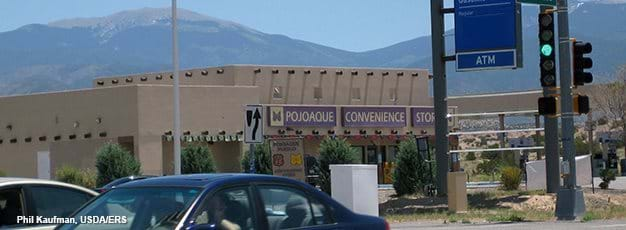Native Americans Living in Tribal Areas Face Longer Trips to the Grocery Store

The prevalence of obesity-related chronic diseases such as heart disease, diabetes, and metabolic syndrome among Native American populations is nearly twice the rate of non-Hispanic White Americans. One possible contributing factor is limited access to affordable, healthy foods in tribal areas. Often, the low population density and high poverty rates of many tribal areas deter grocery chains from operating stores in these areas. Native American households are therefore more likely to patronize smaller local food stores and convenience stores with limited offerings of healthful, affordable food items.
One measure of access to healthful, affordable food is distance from one’s residence to the nearest large grocery store. A recent ERS study used Geographic Information System (GIS) methods to compute distances in 2010 to the nearest grocery store with annual sales of $2 million or more for individuals living in three types of U.S. tribal areas: American Indian Tribal Areas, Oklahoma Tribal Statistical Areas, and Alaska Native Village Statistical Areas. Among these Native American subpopulation groups, there was a disparity in distance to the closest large grocery store when compared to the U.S. national average. Recognizing the reduced access to large grocery stores facing many Native American households, USDA’s Food Distribution Program on Indian Reservations provides a variety of healthful foods to low-income households living in or near tribal areas.
In the study, individuals were ordered by how far they lived from a large grocery store. Upon ranking individuals across the United States in this way, researchers found that the median distance to the closest large grocery store was 0.8 miles, compared to 3.3 miles for individuals living in tribal areas. At the 20th percentile, the distance from an individual’s residence to the nearest large grocery store was 0.3 miles for all U.S. individuals and 0.8 miles for tribal area individuals, but this difference in distance increased at the 50th percentile (0.8 miles for all individuals vs. 3.3 miles for those residing in tribal areas). More remote U.S. households, those at the 80th percentile, were 2.2 miles away from a large grocery store compared to 9.9 miles for the similar percentile of Native American households living in tribal areas.
Distances to the closest large grocery store also varied among the three types of tribal areas. For example, at the 80th percentile, distances to the nearest large grocery store ranged from 12.8 miles for individuals in American Indian Tribal Areas to 7.9 miles for those living in Oklahoma Tribal Statistical Areas.
Measuring Access to Healthful, Affordable Food in American Indian and Alaska Native Tribal Areas, by Phillip Kaufman, Chris Dicken, and Ryan Williams, USDA, Economic Research Service, December 2014


